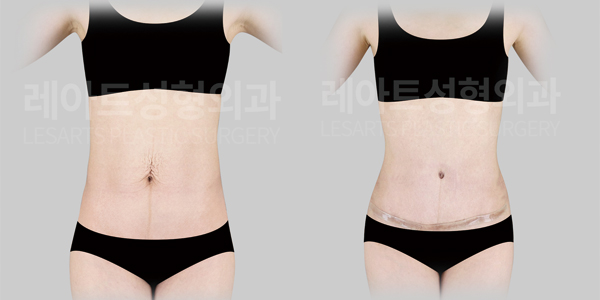Can Abdominal Sagging Be Resolved with Abdominal Lifting or Abdominoplasty?

Information
- Age : early 40’s
- Height : 161cm
- Weight : 51kg
- BMI : 20
Surgical site
- surgical site :abdominoplasty, M-type, Triple lock, Navel Correction, abdomen liposuction
- liposuction aspirate volume : 1400cc
Many people experience abdominal sagging due to pregnancy and childbirth, obesity, or rapid weight loss, resulting in a lack of firmness and a drooping belly due to gravity.
To better understand this, imagine a balloon that has been inflated for a long time—once the air is released, its surface becomes wrinkled and stretched rather than returning to its original shape.
While maintaining a firm body through self-care is possible, factors such as skin elasticity, recovery ability, exercise habits, and nutritional intake differ from person to person. Therefore, a single perfect solution that works for everyone is difficult to achieve.
If your abdominal skin and fat have sagged for various reasons and self-care has not been effective, it may be necessary to seek a more fundamental solution.
This is why an increasing number of individuals consider abdominoplasty after pregnancy, childbirth, or significant weight loss.
Abdominoplasty (tummy tuck) involves tightening separated abdominal muscles and removing excess sagging skin, ultimately improving the overall abdominal contour. This procedure is essentially a body-lifting surgery designed to correct abdominal sagging.
For a more detailed explanation, let’s take a look at a case study of a patient who underwent this procedure.

The patient we will analyze this time is a woman in her early 40s who underwent a cesarean section approximately 10 years ago.
In her case, she experienced significant stress due to loose skin around her navel, reduced skin elasticity, and severe sagging when bending forward, particularly in the lower abdominal area.

The patient had significantly reduced skin elasticity throughout the abdomen and noticeable sagging from the upper abdomen to the area around the navel due to abdominal wall laxity.
To address these concerns, a medium-type abdominoplasty (tummy tuck) was planned to correct sagging skin and loosened abdominal muscles. This procedure would lift and tighten wrinkled abdominal skin, creating a flatter, more defined waistline.
Additionally, a combination of abdominoplasty and liposuction was suggested to further refine and slim the waistline for a more contoured appearance.
Since this patient was a case for medium-type abdominoplasty, a large amount of excess skin needed to be removed, requiring a repositioning of the navel.
The surgical plan aimed to place the navel in a position that would enhance the illusion of a slimmer waist and longer legs for a more proportionate body shape.
Below, we will analyze the medical images taken before surgery and five and a half months postoperatively to provide a detailed explanation.

When comparing the patient’s pre- and post-operative photos taken five months apart, the effects of pregnancy and childbirth on the abdominal skin and muscles are evident.
Before surgery, the patient exhibited sagging and wrinkled skin due to abdominal muscle separation (rectus diastasis) and stretched skin.
In the post-operative images, these issues appear to have been effectively corrected through muscle tightening (rectus plication) and abdominal lifting, resulting in a smoother and firmer abdominal contour.

Additionally, before surgery, when bending forward, the loose skin and weakened abdominal muscles caused sagging from the mid-abdomen down to the lower abdomen, creating wrinkles and a bulky appearance.
After the abdominoplasty, the abdominal contour appears smooth and firm, with no excess skin gathering or wrinkling. The waistline has also become more defined, enhancing an overall slimmer and more toned look.

Additionally, through navel correction surgery, the newly designed shape and position of the belly button contribute to a more natural-looking abdomen and create a visual effect that makes the legs appear longer.
Since this patient is only about five months post-abdominoplasty, they are still in the recovery phase. At this stage, some redness around the incision site is expected, but over time, it will gradually fade and eventually appear as a thin, pale line.
Currently, there are no signs of step-offs along the incision line or complications such as dog ears. The healing process is progressing smoothly, and the patient has been diligently using silicone strips and maintaining proper hydration.
Since scar healing varies from person to person, following the medical team’s post-operative care instructions and attending scheduled follow-up appointments is crucial for a stable recovery.